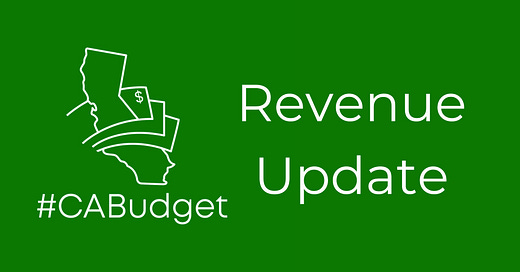Revenues down after LA County tax delay
Despite the revenue delay, state cash position is among the strongest ever recorded
January Income Taxes Below Projections. January 2025 California income tax receipts were $710 million (3.4%) below monthly projections that accompanied the Governor’s January 10 budget proposal. Personal income taxes (PIT) were $174 million (1.0%) below projections, and corporation taxes were $535 million (18.4%) below. This preliminary data comes from the state’s income tax agencies, the Franchise Tax Board (FTB) and the Employment Development Department.
Los Angeles Delay May Have Accounted for Much of Shortfall. FTB conformed with a January 10th Internal Revenue Service decision to delay certain Los Angeles County tax deadlines until October 15. That delay could not be accounted for in the administration’s monthly revenue projections. Many high-income Los Angeles taxpayers delayed their January tax payments, which may have accounted for much, if not most, of the monthly shortfall. (The California Department of Tax and Fee Administration separately extended certain tax filing deadlines for Los Angeles County taxpayers, which will also affect sales and some other tax receipts in the coming months.)
Fiscal Year Income Taxes Running Ahead of Projections. For the 2024-25 fiscal year as a whole, income taxes are running $1.9 billion ahead of the January 10th administration projections through the end of January. That is because December 2024 receipts were $2.6 billion ahead of the estimates, which were completed prior to that month’s receipts being tallied. In particular, PIT withholding is running $2.3 billion (4.0%) above projections for the fiscal year, with receipts well above projections in both December and January. The payment delay for Los Angeles County mainly benefits high-income taxpayers, not working people who pay income taxes via payroll withholding.
Breathtakingly Strong State Cash Position. Despite this revenue news and projections of future annual state budget deficits, the California state treasury’s cash position at the end of January was among the strongest ever recorded by a subnational government. Available (including “borrowable”) cash and cash equivalents on hand in the treasury exceeded $110 billion on January 31, a State Controller’s Office report showed. About 70% of that liquidity was held in non-general funds (such as special funds) in the treasury. (This liquidity generally excludes the vast pension fund holdings for California public employees, teachers, and University of California staff.) By contrast, during the Great Recession on January 31, 2009, the state’s cash on hand was $2.7 billion—all of it borrowed money.
The state’s strong cash on hand results from dramatic changes in state budgeting since the Great Recession, including the voter-approved rainy day fund originally proposed in the Assembly in 2014 and more conservative budgeting practices.
The state’s cash on hand prepares the state well to fund vital services, such as wildfire recovery, in advance of federal reimbursements that are always delayed by years. Nevertheless, the bulk of these funds are not state General Fund moneys, and they are of limited use in balancing future General Fund budgets, as required by the State Constitution. In addition to the current deficit projections, Republican federal leaders’ threats to sharply cut health care funding for Californians risk deepening projected state deficits even further.



